One of Israel’s greatest natural wonders is often missed by tourists because without private transport it requires quite a bit of effort to get there. I am talking about Machtesh Ramon, most often translated as the Ramon Crater. Located approximately 70 kilometres south of Beer Sheva, it is a two and a half hour car ride from Jerusalem, the same time it would take you to reach Haifa if driving north. However when you reach your destination, far from finding yourself in an urban metropolis, you are surrounded by the magnificent scenery of the Negev Desert.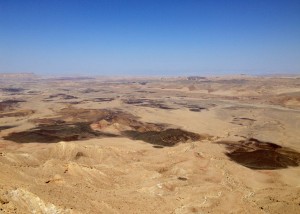
A crater is a formation usually created by a meteorite falling to earth or a volcano erupting, whereas a “machtesh” is a geomorphological phenomenon which occurs as a result of erosion. The correct translation of the Hebrew “machtesh” is an “erosional cirque” and we have four fully formed ones in Israel, with another two baby ones in the process of being created. Similar landforms can also be seen in the Sinai, in Morocco and in the Ural mountains, but of course the most beautiful examples are in Israel. Machtesh Ramon, which is forty kilometers in length and nine metres across at its widest point, is the largest and most picturesque of them.
The process of erosion that led to the creation of the machtesh took place over millions of years. Originally the terrain was not desert, but consisted of rivers and lakes which formed near a shallow sea. Sandstone was deposited at this bottom level and at a later stage was covered with the skeletons and remains of animals that inhabited the sea, which in turn developed into different layers of limestone. Today, this forms the top layer of the Ramon ridge.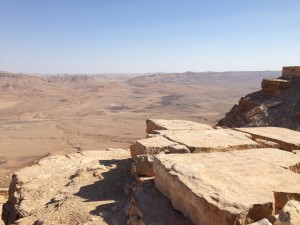
This is because of a process which began with an earthquake and caused the rock to fold into an anticline or A shape and thrust it upwards. Rock which was at the very lowest layer was pushed up to form the peak of the new formation. Chalk and flint and phosphates were added to the layers. Erosion caused by natural weather conditions and later on by another period of flooding detached some of the sand and conglomerates that were at the top of the anticline and scattered them randomly around the formation. As the level of the sea receded, the peak of the machtesh eroded exposing the sandstone underneath. Another wet era brought with it different sandstone and pebbles from far flung areas like Saudi Arabia and added them to the mix and when the waters receded once again they eroded the inner part of the ridge, creating the landscape that we see today. A visitor’s centre at the edge of the site has several exhibits that explain the process. As a visual aid, imagine a hard-boiled egg that has been hit from the top with a spoon. The shell and all that is attached to it implodes making a semi circular dent in the egg, so the inner part of the egg is exposed. A similar but lengthier process occurred to create the machtesh.
There are a number of different options how to enjoy the surrounding scenery. The simplest is just to take a gentle stroll along the two kilometer promenade situated on the edge of the machtesh. If you are more adventurous you can walk along one of the various trails that take you into the machtesh itself. You can enjoy the coloured sandstone and ancient rock formations and choose from a variety of paths that offer a diverse range of routes from an easy meander to a challenging hike.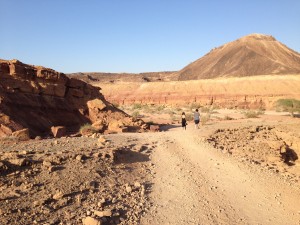
There is a wide variety of wildlife that inhabits the area. Probably the most commonly sighted animal is the Nubian Ibex, which may be familiar to you as it is the symbol of the Society for the Protection of Nature in Israel. There are many of them wandering around the tourist areas, unfazed by the humans they encounter. Vultures and partridges, ravens and many other birds are also frequent visitors to the area. A jeep tour with a knowledgeable guide can take you deep into the machtesh where at night you might be lucky enough to spot a leopard, a caracal or maybe a hyena. Night time excursions give you the opportunity to discover a completely different side of nature after the sun goes down. Another popular nocturnal activity is to do a spot of star gazing. On a clear night in the vast open expanse of desert it is a truly magical experience.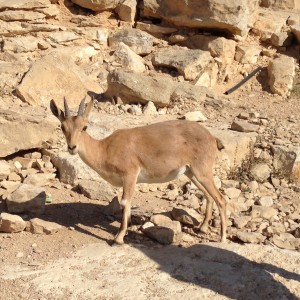
Archaeological discoveries suggest that pre-historic man also made his home in the general vicinity. Flint tools, the remains of villages and large rock piles leave us hints of earlier civilizations, their habits and their rituals. The Negev was part of the inheritance of the tribe of Shimon and later under the rules of Kings David and Solomon a line of fortresses guarded the southern border. Water cisterns dating from this period help us identify their locations.
Traders also crossed the desert here as they travelled along the ancient Incense Route from Petra to Gaza which actually bisected Machtesh Ramon. The Nabateans, the Romans, and later on Byzantine pilgrims all traversed the Negev. After the Arab invasion of the country in the seventh century, settlement in the region came to an end. The area became the province of nomadic tribes for many centuries until the British came and restored order and built new roads and police stations. They also created a regular water supply for the Bedouin to use and began a formal land registry.
In March 1949, during the War of Independence, the Israeli army marched through the Negev all the way down to Eilat. David ben Gurion, the new state’s first prime minister stressed the importance of the Negev and his wish to see the desert bloom. He retired to Kibbutz Sde Boker to help put his plan into practice and you can view his spartan home there which is only a short drive away.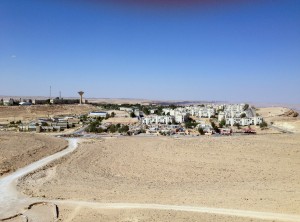
Mitzpe Ramon, the modern town that has built up around the machtesh was originally established as a camp for workers building the road to Eilat .Still a small town with a population of around 5,500, it is host to numerous hotels, guesthouses and hostels where you can base yourself during your stay. They run the range from the luxurious 5 star Beresheet Hotel, to the more budget friendly Ramon Inn, to a bikers’ hostel and field school. There are also authorized camp sites within the machtesh itself. Other attractions in the general area include wineries, farms and ecological activities. So if you are looking for a place to recharge your batteries in the bosom of nature, you may want to factor in a few days in the heart of the Negev Desert during your next visit.
